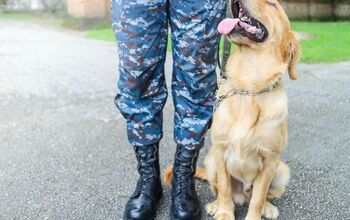Can Dogs Suffer From PTSD

We’re all familiar with the term Post Traumatic Stress Disorder (PTSD) and how it can linger throughout a lifetime for those exposed to highly traumatic or dangerous situations.
Typically, we think of a soldier returning from an active war zone or an individual who has experienced a dramatically destabilizing event/s. But while these instances would understandably generate a temporary fight-or-flight instinct toward self-preservation, with PTSD, that fearful response never ends. It’s a psychiatric disorder that causes the individual to remain in a constant state of high alert for potential threats, and to move through life hobbled by relentless anxiety.
But did you know that dogs that have comes through similarly traumatic situations can also suffer from PTSD?
Causes of PTSD in Dogs
Just like with humans, this behavior is not down to a dog’s individual character or to a breed that is naturally stress-sensitive. It’s caused by situations traumatic to the individual dog that can be as simple as a relinquishment by their family for re-homing or the loss of companionship following the death of a pet parent.
More obvious triggers can include:
- Emotional abuse through a puppy mill or animal hoarding
- Extreme violence including dogfighting
- Chronic physical abuse
- Active duty in a war zone
Or singular instances such as:
- Exposure to a natural disaster – hurricane, tornado, fire, and flooding
- Involvement in a serious accident – a fall down stairs or from a height, a motor vehicle crash or other unexpected incident
Related content: - Big Bang Therapy – How to Keep Your Dog Calm During Fireworks
Recognizing the Signs of PTSD in Dogs
To effectively treat your dog’s PTSD, you need to recognize the signs, identify the cause and be able to distinguish this behavior from other situational reactions. For example, dogs that suffer from separation anxiety will often adopt destructive behaviors such as chewing, urinating, pooping or barking when you leave the house. Dogs that are fearful of loud sounds may begin to cower and hide long before that thunderstorm rolls through. The trick is to separate these more common behaviors and reactions from those caused by PTSD. And that’s where you as the pet parent, enter the picture.
Your vet is going to need as much information as possible about your pooch’s history and will want you to start taking notes about what seems to trigger his fearful actions. What are you looking for?
If your pet has been in the family for a while, look for changes in behavior. A sudden reluctance to go for a car ride, enter a room, climb stairs or hang out with other dogs in a park. He may suddenly become shy or timid when he would typically be outgoing. Visual cues may include crouching low to the ground, panting and pacing, restlessness, tucked tail, clinginess and/or unexpected aggression. He may begin barking for no reason and become highly alert to any noise or movement around him.
Related content: Tips for Welcoming an Abused Dog Into your Family
For pets that are new to your home, consider their history. With the rescue of adult and older dogs becoming a growing (and welcome) trend, don’t hesitate to ask questions about how your pup came to find his way to a rescue. Is he the result of a hoarding or puppy mill situation? Was he removed from a neglectful or abusive home? Is he okay with kids and other dogs? If not, why not?
Once you have a fuller picture, you can work toward a recovery plan. Be aware that no treatment will cure your pet of this condition but it will allow him to live a comfortable, less stressful life.
Treatment of PTSD in Dogs
You may be surprised to learn that dogs don’t have memories. Even though they seem to remember how to perform tricks and respond to basic commands, it is typically a trigger that causes the behavior. And that leads to a couple of easy-to-use methods for minimizing PTSD-related reactions.
The first is called de-sensitization and it requires gentle, continual exposure to a triggering situation. For example, a fear of gunfire, explosions, thunder, and fireworks can be alleviated if you playback a recording of those sounds on a very low volume. Gradually increase the volume each day and over time your dog becomes aware that the offending sound is no longer associated with something negative.
With counter-conditioning, your pet is rewarded with a treat every time a trigger is activated (noise, exposure to kids, dogs, men, or another stimulant). He then begins to associate something positive with the previously negative stimulus.
The third type of treatment you can try at home is simply rough play for a few minutes. Findings by Washington State University show that this type of interaction between owner and dog can result in large amounts of neurotrophic growth in the brain. Simply put, this new growth helps to replace past, negative memories housed in a particular section of the brain. These new cells can actually allow for new, positive interactions to build and replace the negative ones.
And finally, self-discipline. Yes, we’re talking to you as the pet parent. If you’re dog suddenly shifts into a frightened, fragile state, don’t coddle him. If it’s about having to climb into a car, then take him for a walk. If it’s about a stranger at the door, escort him to a separate room. You get the picture. If you constantly soothe him, you’re reinforcing that he’s right to be upset. So, remain calm and allow your voice, body language and actions to show him there’s nothing to worry about.
Tips to Minimize the Meltdowns
Bringing your beloved pooch back to a reasonable state of Zen takes time, effort and patience. He will always have triggers you need to manage – that will never change - but you can help him lead a less-stressed life by introducing a few simple steps:
1. Establishing a Routine
Predictability is important for all dogs and allows them to anticipate how their day is going to unfold. This includes walks so they understand when and where they can relieve themselves, meals so they know those hunger pangs are temporary as well as treats for special behaviors. Dogs just aren’t big on surprises and the more structured the day, the less stress he’ll have.
2. Create a Safe Place
Your pet needs a place where they can retreat to when anxiety starts to build. It could be a dog bed, a crate, or just a favorite blanket on the floor. Not sure where to put it? Let your dog decide on this one. If you have a beautiful plush bed set up by the TV set but he tends to retreat to the basement, then that’s where his bed should be. Particularly with dogs dealing with PTSD, you need to create a safe, predictable space that he knows will be waiting for him. And toss in an old t-shirt or a piece of clothing with your scent on it for added comfort.
3. Lose the Medications
Before you opt to give your pet medication – such as beta-blockers to help slow his heart rate or CBD oil to help him chill out – consider tweaking his diet. Did you know that your pooch will benefit from the same Omega-3 oils that you use for brain and heart health? Additionally, you might want to check into some of the natural body-calming therapies such as weighted blankets, thunder-shirts that are proven to prevent hyper-ventilating and also hands-on body massage to help relieve stress.

Sharing space with three seriously judgy Schnoodles and a feline who prefers to be left alone. #LivingMyBestLife
More by Mary Simpson























